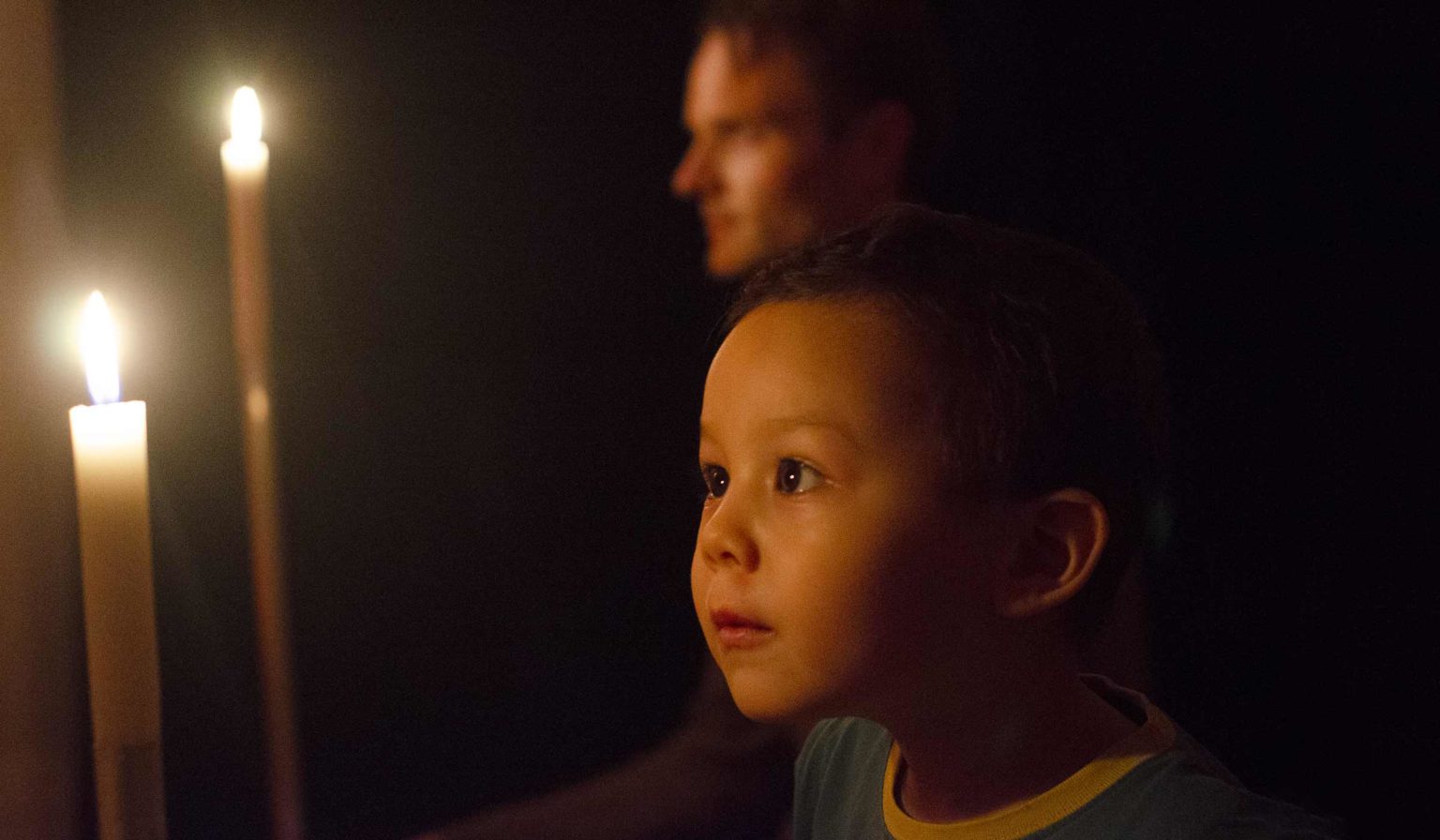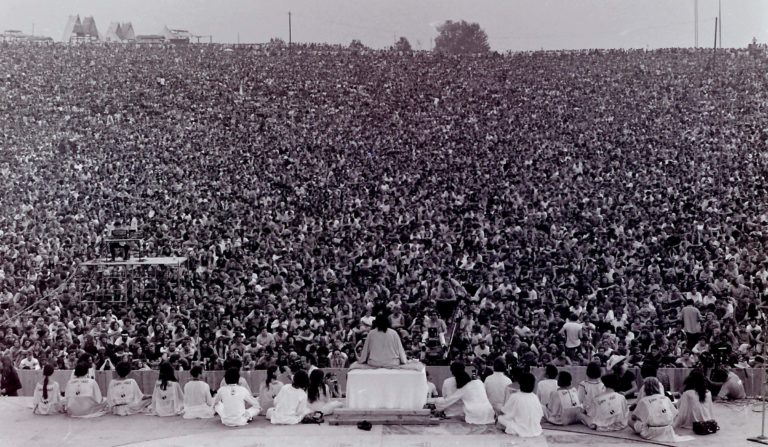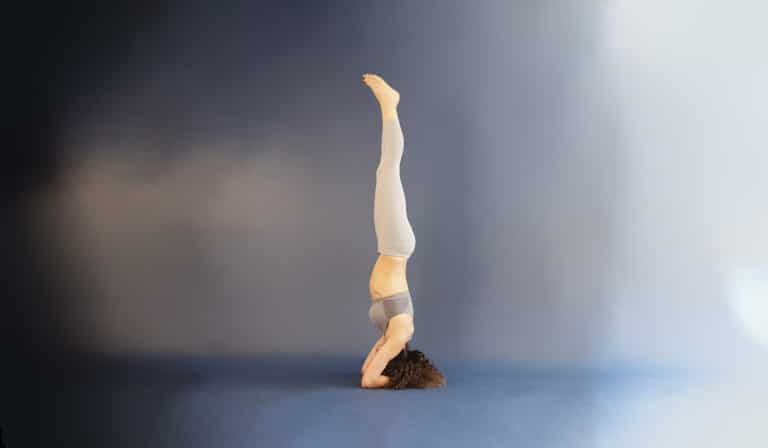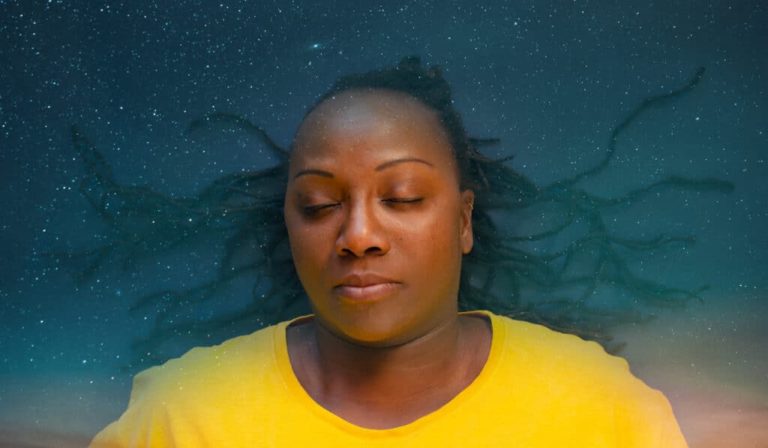Yoga has given you so much. I am sure you would love your kids to benefit from it as well. But playing around with animal poses, though it’s fun, won’t impact them in-depth. Here are five simple yet profound yoga exercises for kids that will. They will train your children’s concentration, self-control and capacity to be present. The best part is that they will love to share these remarkable experiences with you.
These are the five kids yoga exercises I frequently do with my children. I have chosen them because they have a real impact and because they are easy to do. By regularly letting your children do these practices you will help them to strengthen their concentration and awareness from an early age.
I think these child friendly yoga practices are so great that I want share them with other yogi parents. So, let’s get started!
Rotation of consciousness
First up is rotation of consciousness. It is a practice from the meditative deep-relaxation Yoga Nidra. It consists of feeling a specific body part for a short while and then moving on to the next. In such a way, you rotate your awareness throughout your whole body. It trains body awareness, has a relaxing effect on the nervous system and activates natural healing.
Adults usually practice rotation of consciousness following verbal instructions from a guide or a recording; however, for a small child, that is too complicated. Luckily you as a parent can help. You have to be the guide, something your child will love.
To guide children through rotation of consciousness, you will touch the body part you want your child to focus on. That will make it easy for them to bring awareness to that location. Stay about two seconds with each body part before switching to the next.
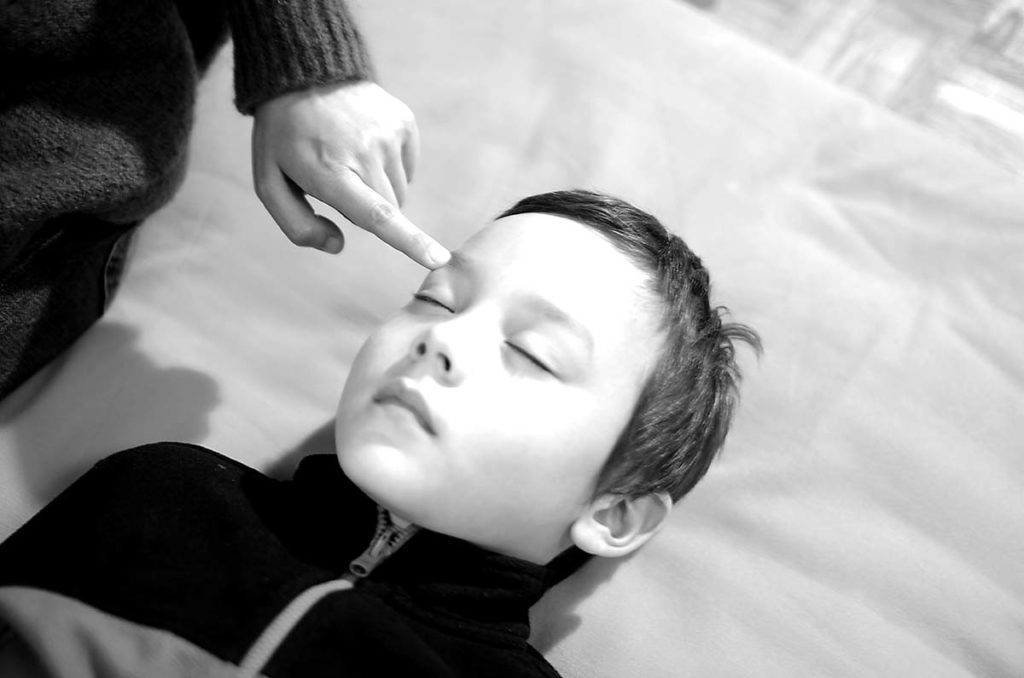
Your child will adore your gentle touch and the sense of connection and closeness it gives. Thus this concentration training will become a precious memory, connecting the act of concentrating with something safe and pleasant. As a bonus, your child will learn the names of specific body parts.
How to guide rotation of consciousness for a child
Ask your child to lie down on the bed or on a yoga mat with eyes closed. Encourage him or her to remain silent and feel the body parts you will be touching. You can follow the sequence that I guide in my long Yoga Nidra here on Forceful Tranquility with some modifications. See below for complete instructions.
Instructions for rotation of consciousness
Here follows a transcript of rotation of consciousness adapted for children.
Section 1 – Right and left side
Feel the thumb of your right hand. Feel the index finger, the middle finger, ring finger, little finger. Feel your palm, the back of the hand, your whole hand. Feel the wrist, the forearm, the elbow, the upper arm. Feel your shoulder, the armpit, the right side of the chest, right waist, hip, thigh, knee cap, fold of the knee, calf muscle, shin bone, the ankle, the heel, the sole of the foot, the arch, the middle of the sole of the foot, the ball. Feel your right big toe, second toe, third toe, fourth toe, fifth toe.
Experience your left-hand thumb, index finger, middle finger, ring finger, little finger. Feel the palm of your left hand, the back of the hand, the whole hand. Feel the wrist, forearm, elbow, upper arm, shoulder, armpit, left side of the chest. Feel your left waist, your hip, thigh, knee, calf, shin bone, ankle, heel, the sole of the foot, the arch, the middle of the sole, the ball. Feel your left big toe, second toe, third toe, fourth toe, fifth toe.
Experience the soles of both of your feet.
Section 2 Head, torso and whole body
Feel the top of the head, forehead, right ear, left ear, right cheek, left cheek, right temple, left temple, right eyebrow, left eyebrow, the centre between the two eyebrows.
Feel your nose, feel the tip of your nose, upper lip, lower lip, the contact between the lips. Feel your chin, your throat, the right collar bone, the left collar bone. Feel the right part of your chest, the left part of your chest, the depression underneath the chest, the whole chest. Feel your heart, your stomach, navel, abdomen.
Feel your whole right leg, your whole left leg, whole right arm, whole left arm. Feel your whole head. The whole head. The whole head.
Now experience your entire body. The whole body. Feel your whole body. Awareness of your entire body.
At the very end, while instructing your child to feel the whole body, let your hands swiftly but gently brush over your child’s entire body.
Optional visualisation
If your child seems receptive, you could add a basic visualisation at the end. For example, ask your child to recall a moment of joy, like a day on the beach. You could ask your child to see him or herself together with the rest of the family, all enjoying themselves.
You could also ask your child to recall a moment of awe, for example, seeing the moon or the stars.
Then ask your child to imagine a calm situation, like gently petting an animal or hugging a teddy bear. If you are guiding this relaxation in the evening before bedtime, then wrap up by asking your child to imagine falling asleep.
When to guide a relaxation to your child
The best time to do this yoga nidra inspired relaxation is when your child is in connection with a nap or as a part of a bedtime ritual. Children like the safety of repetition, so don’t be surprised if you will be asked to do this relaxation again and again.
From what age can children do rotation of consciousness?
That depends on your child. Most children would appreciate this from around the age of three and some even earlier.
Duration
This child-friendly relaxation could last around five minutes. You can shorten or prolong it depending on how well it goes.
Immobility
Do you think children don’t like to sit still? This is because you have not combined it with an element that all kids love: You have to be playful about it and turn it into a game. Challenge them to see for how long they can sit still. Then clock them while you observe them closely. The game will be fun for them, and they will feel your support and attention since you will be there watching them.
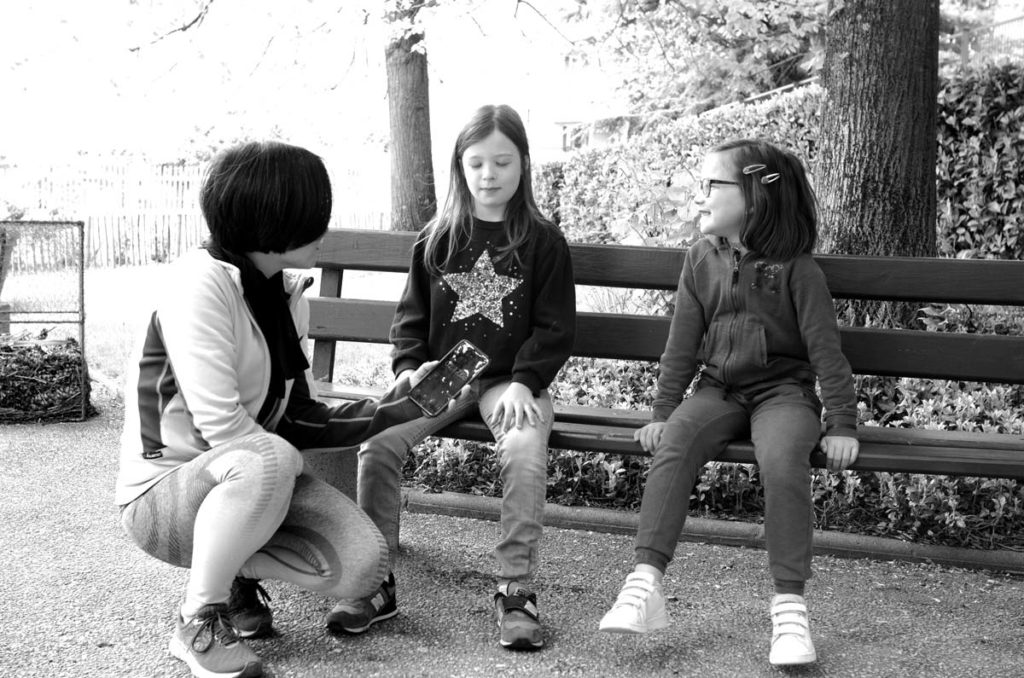
With this practice, your child will train to resist all impulses of moving. This makes it a powerful yogic exercise of self-control.
I once met a mother travelling together with her three restless kids on a train. I introduced this exercise to her boys. Her jaws dropped when her eight years old stayed perfectly immobile for twenty minutes.
The marshmallow experiment
Have you heard of the marshmallow experiment? Scientists tested if a child could resist the impulse of eating a marshmallow left in front of them while being left unsupervised. The researchers then did follow up studies with the kids as they grew up. It turned out that the ability to resist the tempting marshmallow had a massive impact on how successful they were in life. Developing impulse control is crucial for children, and it makes sense to train them from an early age.
How to practice motionlessness with a child
Ask your child to sit in a chair and get ready not to move. Then start your timer and stop it when your child breaks the immobility. Feel free to indicate how much time has passed as that can be a motivation to break previous records.
When to practice motionless with your child
You can do this practice with your kid at any time.
From what age can children do motionlessness
You can try this experience with your child from the age of four.
Tratak for kids
Tratak is a yogic concentration technique and a perfect practice for kids. You proceed by fixing your gaze in the flame of a candle. For children, candles are fascinating, especially a candle in a dark room. This makes the flame an attractive concentration object.
To do tratak, sit down in a meditation pose. Make sure that you have the candle at eye level and around one meter away from your face. Don’t let your child practice very close to the flame as the light might be too strong for the eyes.
How to practice tratak with a child
You have to guide the practice. Follow the exact instructions that I use for tratak here on Forceful Tranquility. You can also find tratak instructions in my article on how to practice tratak for adults. Just make your session shorter. Around five minutes, all steps included is enough for a child.
There is one instruction specific to kids, though. Let your child blow out the candle if they want to. That is fun and can contribute to them wanting to practice more.
When to practice tratak with a child
The evening is perfect for tratak. Adults confirm that tratak gives good sleep, and I find that my six-year-old falls asleep quickly after this practice.
From what age can children practice tratak
Tratak is tricky for most children under five since it requires a good level of concentration. But from that age on, you can give it a try.
Bhramari pranayama
Bhramari pranayama is an easy breathing exercise from the hatha yoga tradition. It has a soothing effect on the nervous system inducing natural relaxation and reducing anxiety. It is another great yoga exercise that your kids will love.
You do bhramari pranayama by closing your ears and making a humming sound on the out-breath. Then you listen to the sound vibrating in your head. Please read my article dedicated to bhramari for more information about its benefits.
How to practice bhramari with a child
Explain in advance to your child how to do the practice since your child won’t hear any instructions with his or her ears plugged.
First, sit down, preferably in a meditation pose, with the hands resting on the knees. Encourage your child to sit motionless with his or her eyes closed. After a minute or so of quiet time, ask your child to take a deep breath, close his or her ears, and then breathe out, making the humming sound. If plugging their ears with the index finger like adults is too complicated, the child can use the palm of their hands.
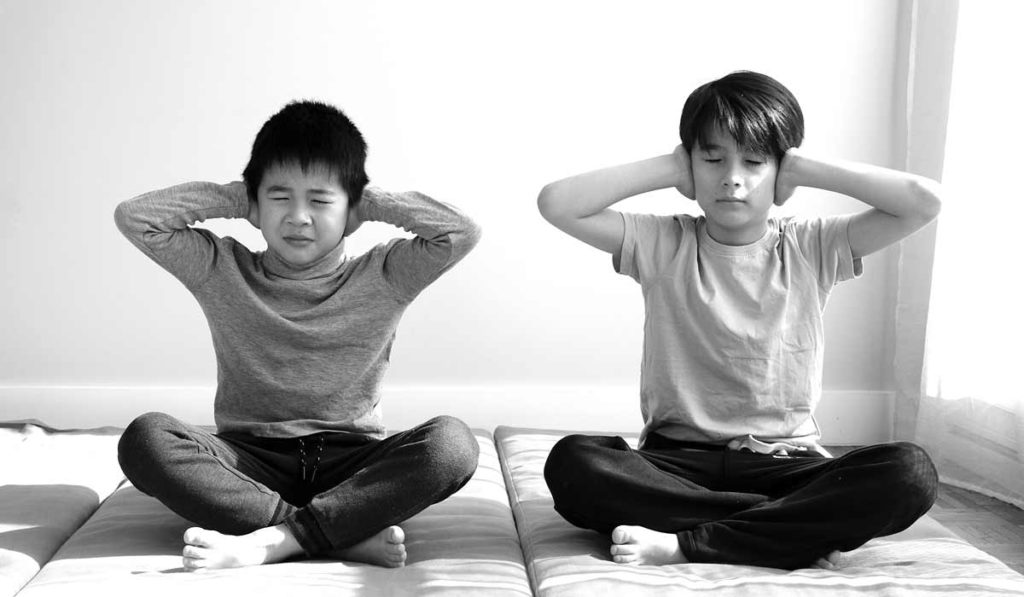
Ask your child to bring the hands back to the knees. Wait a little while before continuing. Do five to nine repetitions and then sit quietly for another minute. Altogether it should take five, six minutes.
Yogic Silence
In the yoga tradition, silence is called Mauna, and it is one of my favourite yoga practices to do with children. Silence is magical because it helps us to know ourselves. However, in the modern world, it has become a rare resource. Both adults and children are constantly bombarded with stimuli that conceals what is going on inside us, depriving us of a healthy connection with our natural surroundings and with ourselves.
By training to appreciate and be comfortable with silence, your child will learn to accept his or her inner landscape and reinforce the capability to connect non verbally. Silence is also a fantastic activity to do together with children. And they very often find it natural.
How to practice silence with your kids
The procedure starts with deciding on a time; I recommend five minutes. Everybody agrees not to say anything (or communicate with gestures, for that matter). Set an alarm that will go off to mark the end of the period of silence. Then you sit together quietly, appreciating the moment.
You can practice silence at any time. The evening is particularly appropriate. Sitting outside late on a summer evening can be especially impressive to children.
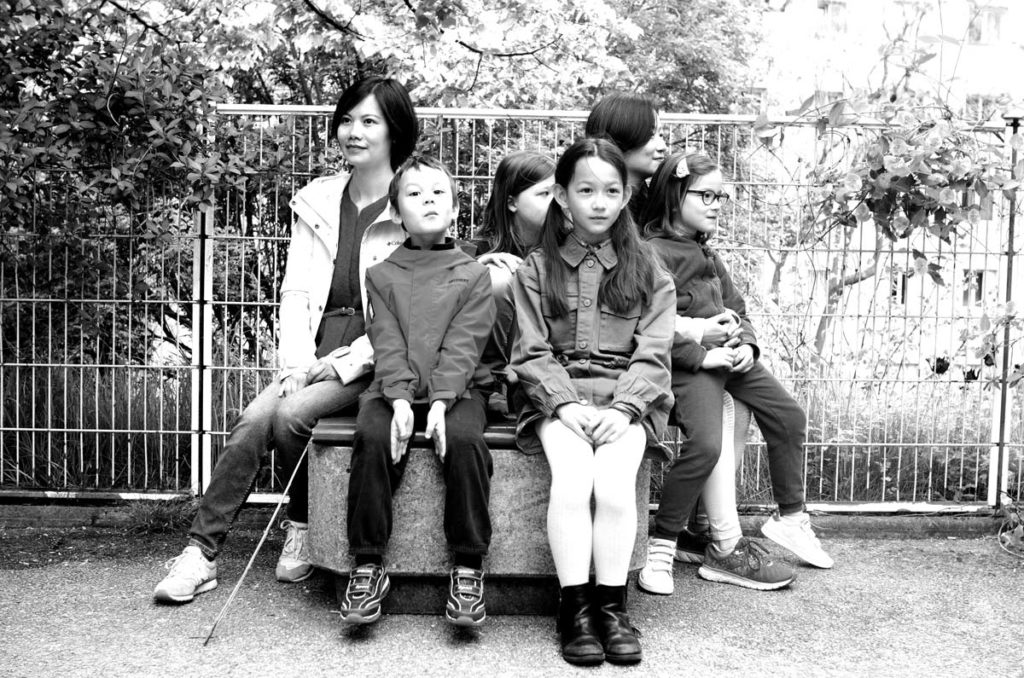
The twilight hour
This type of informal silent meditation used to be very common in Scandinavian countries just a few generations ago. Entire families would sit silently together as the sun went down, before turning on the lights. The custom went by many different names. One of them was the Twilight Hour. My teacher, Swami Janakananda, has collected testimonials about it from students who experienced it as children and accounts of it from books. I am a big fan of children’s books by Swedish author Astrid Lindgren. In her books, there are numerous references to this practice. Not the least in the essay In the land of twilight, first published in 1949
Key takeaways
- It is desirable to introduce yoga to kids early. Don’t limit kids’ yoga to poses as there is so much more than that. Just remember to keep it playful and without demands.
- Yogic parents can easily adapt rotation of consciousness, motionlessness, bhramari, tratak and silence for kids. They are profound and yet fun for kids to do. Most importantly, doing these practices together with your kids can bring you closer together.
- For lasting benefits, keep the sessions short but repeat frequently. Making a yoga exercise part of your daily planning family planning is excellent.
